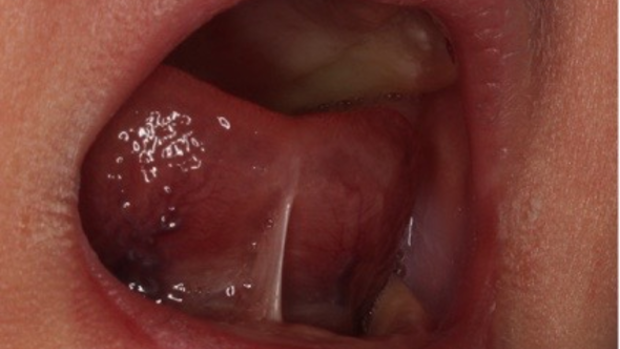A newborn frenotomy is a minor surgical procedure that addresses a condition called tongue-tie, or ankyloglossia, in which the small strip of tissue under the tongue, known as the frenulum, is unusually short or tight. This restricts the tongue’s movement, making breastfeeding difficult for some babies and, if untreated, potentially leading to speech difficulties or dental problems later in life. A frenotomy involves cutting this small band of tissue to allow greater freedom of movement for the tongue. The procedure is typically performed in newborns who are experiencing difficulty breastfeeding due to the restricted tongue movement, and it is a quick and relatively simple intervention that often results in immediate improvement in the baby’s ability to latch onto the breast and feed properly.
Understanding Tongue-Tie in Newborns
Tongue-tie is a congenital condition present at birth, affecting the mobility of the tongue due to a short or tight frenulum. This condition can interfere with breastfeeding because the baby may struggle to latch properly, which can cause pain for the mother and prevent the baby from getting enough milk. The severity of tongue-tie varies widely. In some cases, the restriction is minimal, and the baby can still feed effectively, while in other cases, the restriction is significant enough to require intervention. This condition affects around 4-10% of newborns, and it is often identified in the first few days of life as the mother and baby begin breastfeeding. Early diagnosis of tongue-tie is crucial, as untreated cases can lead to ongoing feeding problems and even affect the child’s ability to speak properly in the future
The Frenotomy Procedure
A newborn frenotomy is one of the simplest medical procedures, usually taking just a few minutes to perform. In most cases, it does not require any anesthesia, as the frenulum contains very few nerve endings. During the procedure, a healthcare provider uses sterilized scissors to make a small incision in the frenulum, which frees the tongue and allows for improved movement. In some cases, a laser might be used instead of scissors, depending on the healthcare provider's preference. The procedure is quick, and babies are often able to feed immediately afterward. Most parents notice an improvement in breastfeeding right away, as the baby can latch more effectively onto the breast. The baby may experience minimal discomfort during the procedure, and healing generally occurs within a few days without any complications.
The Role of Frenotomy in Breastfeeding Success
The primary reason for performing a frenotomy in newborns is to address breastfeeding difficulties caused by tongue-tie. When a baby’s tongue is restricted by the frenulum, they may struggle to latch onto the breast correctly, which can cause nipple pain for the mother and prevent the baby from effectively drawing milk. Poor latch can lead to inadequate milk intake, which in turn can result in poor weight gain for the baby. For mothers, this may lead to issues like cracked or sore nipples, blocked milk ducts, and even mastitis, a painful breast infection. A successful frenotomy can make a significant difference in the breastfeeding experience for both mother and child. By freeing the tongue, the baby can latch better, resulting in more efficient feeding, less pain for the mother, and improved weight gain for the baby.
Long-Term Benefits of Newborn Frenotomy
While the immediate benefits of frenotomy in terms of breastfeeding are clear, the procedure also offers long-term advantages. If left untreated, tongue-tie can cause speech difficulties as the child grows older. Certain sounds, such as "t," "d," "z," and "r," require precise tongue movement, and children with restricted tongue mobility may struggle to form these sounds properly. In addition to speech issues, tongue-tie can affect the development of the mouth and teeth. In some cases, it can cause a gap between the lower front teeth or lead to problems with chewing and swallowing. By performing a frenotomy early in life, parents can help prevent these potential complications, ensuring that their child develops normally and without the limitations imposed by tongue-tie.
The Rising Awareness and Prevalence of Frenotomy
In recent years, frenotomy has become a more common procedure as awareness of tongue-tie and its effects on breastfeeding has increased. More healthcare providers are now trained to recognize the signs of tongue-tie, and parents are becoming more informed about the potential benefits of early intervention. The rising emphasis on breastfeeding and the growing body of research supporting the importance of successful breastfeeding have contributed to the increasing prevalence of frenotomy. Despite this, it is important to note that not all cases of tongue-tie require surgery. Some babies can still breastfeed effectively even with a mild tongue-tie, and the decision to perform a frenotomy should be based on the severity of the restriction and the impact it is having on feeding.
Controversies Surrounding Frenotomy
While frenotomy is widely regarded as a safe and effective procedure, there is some debate over whether it is always necessary. Critics argue that tongue-tie is sometimes overdiagnosed and that not all cases require surgical intervention. In some cases, feeding problems may be due to other factors, such as positioning or latch technique, rather than tongue-tie itself. It is important for healthcare providers to carefully assess each case and consider other factors before recommending a frenotomy. That said, many lactation consultants and pediatricians support the procedure when there is clear evidence that the baby’s tongue-tie is interfering with feeding. Ultimately, the decision to proceed with a frenotomy should be made after a thorough evaluation and discussion between the parents and their healthcare provider.
Recovery and Care After Frenotomy
After a newborn frenotomy, recovery is typically quick and uneventful. Most babies are able to feed immediately after the procedure, and any discomfort they experience is usually minimal and short-lived. Parents may be advised to perform gentle exercises under the baby’s tongue to prevent the frenulum from reattaching as it heals. In most cases, the wound heals within a few days, and there are no complications. However, parents should monitor their baby for signs of infection or any difficulty feeding that may arise after the procedure. Regular follow-up appointments with a healthcare provider can ensure that the baby is healing properly and that breastfeeding is improving as expected. In rare cases, if the frenulum reattaches or feeding problems persist, a second procedure may be required, but this is uncommon.
/assets/images/provider/photos/2458463.jpg)
Conclusion
Newborn frenotomy is a safe and effective procedure that addresses the issue of tongue-tie, a condition that can significantly impact breastfeeding and, if left untreated, lead to long-term oral health and speech problems. By releasing the tight frenulum, the baby’s tongue is able to move more freely, improving breastfeeding and reducing the risk of future complications. As awareness of the benefits of frenotomy has grown, more parents and healthcare providers are recognizing the value of early intervention. While not all cases of tongue-tie require surgery, frenotomy can be a valuable tool in ensuring the success of breastfeeding and promoting the child’s overall development.
FAQs
What is a newborn frenotomy?
A newborn frenotomy is a minor surgical procedure that involves cutting the frenulum under the baby’s tongue to release tongue-tie.
How common is tongue-tie in newborns?
Tongue-tie occurs in about 4-10% of newborns, but not all cases require a frenotomy. The decision to perform the procedure depends on the severity of the condition and its impact on feeding.
Is a frenotomy painful for the baby?
The procedure is usually not painful because the frenulum has few nerve endings. Babies typically recover quickly and can breastfeed immediately after the procedure.
What are the long-term benefits of a frenotomy?
In addition to improving breastfeeding, a frenotomy can prevent speech problems, dental issues, and other oral health complications that may arise from untreated tongue-tie.
How long does it take for a baby to recover from a frenotomy?
Most babies recover within a few days after the procedure, with minimal discomfort. Feeding improvements are often noticed immediately.









